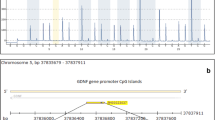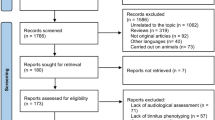Abstract
Glial cell line-derived neurotrophic factor (GDNF) plays a key role in early development of central auditory pathway and the inner ear. However, the auditory pathway studies of GDNF gene polymorphisms are scarce in the literature, and the studies especially associated with tinnitus are limited. Our study aimed to identify whether GDNF gene polymorphisms play any roles in the pathophysiology of tinnitus by investigating the relationship between tinnitus and GDNF polymorphisms. A total of 52 patients with chronic tinnitus and ages ranging from 18 to 55 were admitted to the Ear–Nose–Throat outpatient clinic of Celal Bayar University Medical Faculty Hospital of Manisa, Turkey and constituted the study group. Another 42 patients of the same age range, without tinnitus symptoms and lacking any systemic disease, were also admitted to the clinic and formed the control group. The tympanometric, audiological, and psychoacoustic assessments of the subjects were performed. Deoxyribonucleic acid samples obtained using venous blood taken for routine inspections were used to investigate GDNF gene polymorphisms (rs884344, rs3812047, and rs1110149) by polymerase chain reaction-based restriction fragment length polymorphism method. No correlation could be detected between GDNF rs884344 and rs3812047 polymorphisms and subjects with tinnitus (p > 0.05). Heterozygosity was significantly lower for GDNF rs1110149 polymorphism in tinnitus subjects compared to the controls (p < 0.05). However, the allele frequencies for all 3 polymorphisms were not significantly different between tinnitus and control groups (p > 0.05). Failure to detect correlations between tinnitus and GDNF gene polymorphisms suggests this may be due to the fact that the GDNF gene has a variable expression pattern in different tissues and pathologies. Therefore, the study should be improved and its scope should be expanded by including a larger group of patients and different tissues to investigate the expression pattern of GDNF.


Similar content being viewed by others
References
Bauer CA, Turner JG, Caspary DM, Myers KS, Brozoski T (2008) Tinnitus and inferior colliculus activity in chinchillas related to three distinct patterns of cochlear trauma. J Neurosci Res 86(11):2564–2578
Bermingham N, Hillermann R, Gilmour F, Martin JE, Fisher EM (1995) Human glial cell line-derived neurotrophic factor (GDNF) maps to chromosome 5. Hum Genet 96(6):671–673
Eggermont JJ (2000) Physcological mechanisms and neural models. In: Tyler RS (ed) Tinnitus Handbook. Singular Publishing Group, San Diego, p 85121
Eggermont JJ, Komiya H (2000) Moderate noise trauma in juvenile cats results in profound cortical topographic map changes in adulthood. Hear Res 142(1–2):89–101
Eggermont JJ, Roberts LE (2004) The neuroscience of tinnitus. Trends Neurosci 27(11):676–682
Eggermont JJ, Roberts LE (2012) The neuroscience of tinnitus: Understanding abnormal and normal auditory perception. Front Syst Neurosci 6(53):1–4
Folmer RL, Shi YB (2004) SSRI use by tinnitus patients: Interactions between depression and tinnitus severity. Ear Nose Throat J 83(2):107–108
Jastreboff PJ, Hazell JWP (2008) Tinnitus retraining therapy. Cambridge University Press, Cambridge
Jastreboff PJ, Gray WC, Mattox DE (1998) Tinnitus and hyperacusis. In: Cummings CW (ed) Otolaryngology head and neck surgery, 3rd edn. Mosby-Year Book, St Louis, pp 3198–3222
Juckel G, Schumacher C, Giegling I, Assion HJ, Mavrogiorgou P, Pogarell O, Mulert C, Hegerl U, Norra C, Rujescu D (2010) Serotonergic functioning as measured by the loudness dependence of auditory evoked potentials is related to a haplotype in the brain-derived neurotrophic factor (BDNF) gene. J Psychiatr Res 44(8):541–546
Koester M, Storck C, Zorowka P (2004) [Tinnitus–classification, causes, diagnosis, treatment and prognosis]. MMW Fortschr Med 146(1–2):23–4, 26–8. (German)
Kotan Z, Sarandol A, Eker SS, Akkaya C (2009) [Depression, neuroplasticity and neurotrophic factors]. Curr Approaches Psychiatr 1:22–35. Turkish
Langguth B, Hajak G, Kleinjung T, Cacace AT, Moller AR (2007) Tinnitus: pathophysiology and treatment. Elsevier, Oxford
Langguth B, Kreuzer PM, Kleinjung T, DeRidder D (2013) Tinnitus: causes and clinical management. Lancet Neurol 12(9):920–930
Martin DM, Raphael Y (2003) Gene-based diagnostic and treatment methods for tinnitus. Int Tinnitus J 9(1):3–10
Moller AR, Langguth B, DeRidder D, Kleinjung T (2011) Textbook of tinnitus. Springer, New York
Noell CA, Meyerhoff WL (2003) Tinnitus. Diagnosis and treatment of this elusive symptom. Geriatrics 58(2):28–34
Nondahl DM, Cruickshanks KJ, Wiley TL, Klein BEK, Klein R, Chappell R, Tweed TS (2010) The 10-year incidance of tinnitus among older adults. Int J Audiol 49(8):580–585
Norena AJ, Eggermont JJ (2003) Changes in spontaneous neural activity immediately after an acoustic trauma: implications for neural correlates of tinnitus. Hear Res 183(1–2):137–153
Norena A, Micheyl C, Chéry-Croze S, Collet L (2002) Psychoacoustic characterization of the tinnitus spectrum: Implications for the underlying mechanisms of tinnitus. Audiol Neurootol 7(6):358–369
Pan T, Tyler RS, Ji H, Coelho C, Gehringer AK, Gogel SA (2009) The relationship between tinnitus pitch and the audiogram. Int J Audiol 48(5):277–294
Reichardt LF (2006) Neurotrophin-regulated signalling pathways. Philos Trans R Soc Lond B Biol Sci 361(1473):1545–1564
Roberts LE, Moffat G, Bosnyak DJ (2006) Residual inhibition functions in relation to tinnitus spectra and auditory threshold shift. Acta Otolaryngol Suppl 556:27–33
Sand PG, Langguth B, Kleinjung T, Eichhammer P (2007) Genetics of chronic tinnitus. Prog Brain Res 166:159–168
Sand PG, Langguth B, Schecklmann M, Kleinjung T (2012) GDNF and BDNF gene interplay in chronic tinnitus. Int J Mol Epidemiol Genet 3(3):245–251
Schmidt JA, Avarbock MR, Tobias JW, Brinster RL (2009) Identification of glial cell line-derived neurotrophic factor-regulated genes important for spermatogonial stem cell self-renewal in the rat. Biol Reprod 81(1):56–66
Seki S, Eggermont JJ (2003) Changes in spontaneous firing rated and neural synchrony in cat primary auditory cortex after localized tone-induced hearing loss. Hear Res 180(1–2):28–38
Stover T, Nam Y, Gong TL, Lomax MI, Altschuler RA (2001) Glial cell line-derived neurotrophic factor (GDNF) and its receptor complex are expressed in the auditory nerve of the mature rat cochlea. Hear Res 155(1–2):143–151
Sun H, Huang A, Cao S (2011) Current status and prospects of gene therapy for the inner ear. Hum Gene Ther 22(11):1311–1322
Tinnitus Patient Survey: Information from The American Tinnitus Association (ATA) (1986), Oregon
Yilmaz I, Akkuzu B, Cakmak O, Ozluoglu LN (2002) [Use of misoprostol in tinnitus]. Otoskop 3(2):49–56. (Turkish)
Acknowledgments
The authors would like to thank Dr. Olcay Boyacioglu for his help in performing the statistical analyses and writing the manuscript.
Author information
Authors and Affiliations
Corresponding author
Ethics declarations
Conflict of interest
The authors declare that they have no conflict of interest.
Ethical Approval
This study was conducted in accordance with the good clinical practice and applicable regulatory requirements by the Declaration of Helsinki. The study was approved by the Celal Bayar University Institutional Review Board in 2014. IRB-approved informed consent form that informed the study participants about the genetic analysis on their specimens was obtained from each subject prior to any study-related procedure.
Rights and permissions
About this article
Cite this article
Orenay-Boyacioglu, S., Coskunoglu, A., Caki, Z. et al. Relationship Between Chronic Tinnitus and Glial Cell Line-Derived Neurotrophic Factor Gene rs3812047, rs1110149, and rs884344 Polymorphisms in a Turkish Population. Biochem Genet 54, 552–563 (2016). https://doi.org/10.1007/s10528-016-9741-1
Received:
Accepted:
Published:
Issue Date:
DOI: https://doi.org/10.1007/s10528-016-9741-1




